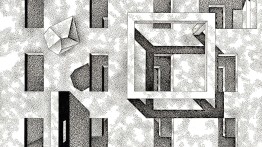Online Exhibition | Franco Purini: Exercises of Claustrophobia
Mon, Aug 30, 2021 12pm - Sun, Sep 26, 2021 6pm

Exercises of Claustrophobia, No. 8, detail. Franco Purini, 2018.
This online exhibition presents, in digital form, Franco Purini: Exercises of Claustrophobia, an exhibition celebrating the work of the Italian architect Franco Purini and his generous gift of drawings to The Irwin S. Chanin School of Architecture Archive. Though COVID-19 restrictions currently limit entry to the physical exhibition, this digital presentation affords broad public access to Purini’s remarkable work.
In 2017, The Irwin S. Chanin School of Architecture first exhibited Purini's drawings in conjunction with the exhibition Geostories: Another Architecture for the Environment, which highlighted the work of Rania Ghosn and El Hadi Jazairy. These concurrent presentations were united by Architectural Tropes Across Scales and Geographies, a dialogue between Purini, Ghosn, and Jazairy. A year later, as a gesture of thanks to the School of Architecture, Purini created a suite of fifteen drawings titled Exercises of Claustrophobia. These works, which Purini refers to as a small visual poem, address the tension between freedom and constraint, which from Purini’s perspective has always existed within the discipline of architecture:

Preceded by a table-frontispiece, the fourteen drawings of the series Exercises of Claustrophobia revolve around a theme that has always fascinated me. It is the architectural relationship between construction and freedom. Although in Latin etymology the word ‘space’ is associated with openness, what it identifies is configured according to me, on the contrary, by means of fences, real or virtual. In a word, space is not an unlimited extension, but it is made of perimeter regions that give life, for those who can see it, to a system of cells in contact with each other, that is to say a fabric, often very dense, of elementary units. Using space, painting is like a cretto by Alberto Burri or a painting by Jackson Pollock. It is in fact a sort of mosaic of parts of different shapes and variable widths. This applies to the landscape, to the city, and to any building. Thinking about architecture therefore means finding a balance that, by its nature, can only be unstable, between closure and openness, between a strongly partitioned structuring of the space and the partial destruction of the space itself. In short, architecture is the search for freedom within a universe severely divided into separate sections, it is a living dialectic between a Piranesian reclusion and continually interrupted logical-poetic evasions.
Following the Third Floor Hallway Gallery exhibition, the drawings will be available for further study in the Architecture Archive as part of its growing collection of original works by architects.
The exhibition texts accompanying the drawings have been excerpted from Purini’s article “Random and Provisional Notes on Drawing,” published in diségno in June, 2020.
Franco Purini
Franco Purini is an Italian architect, writer, and professor. He has been a professor of architecture and urban design at the I.U.A.V. and at the School of Architecture Valle Giulia at La Sapienza University in Rome, where he is currently professor emeritus. Since 1966 he has been in partnership with Laura Thermes, with whom he has shared theoretical investigations and design experimentations concerning the debate on architectural language and complex urban issues. Their work combines a strong rational component with figurative suggestions drawn from the classical tradition. For his professional and theoretical work Purini was elected “Accademico Correspondente” at the Academy of Drawing Arts in Florence and is a member of the Accademia di San Luca. His drawings are dense with lines, references, and textures while his projects echo classic rationalism and tradition, with clear references to metaphysical aspects of work by Maurizio Sacripanti and Giovanni Battista Piranesi.





